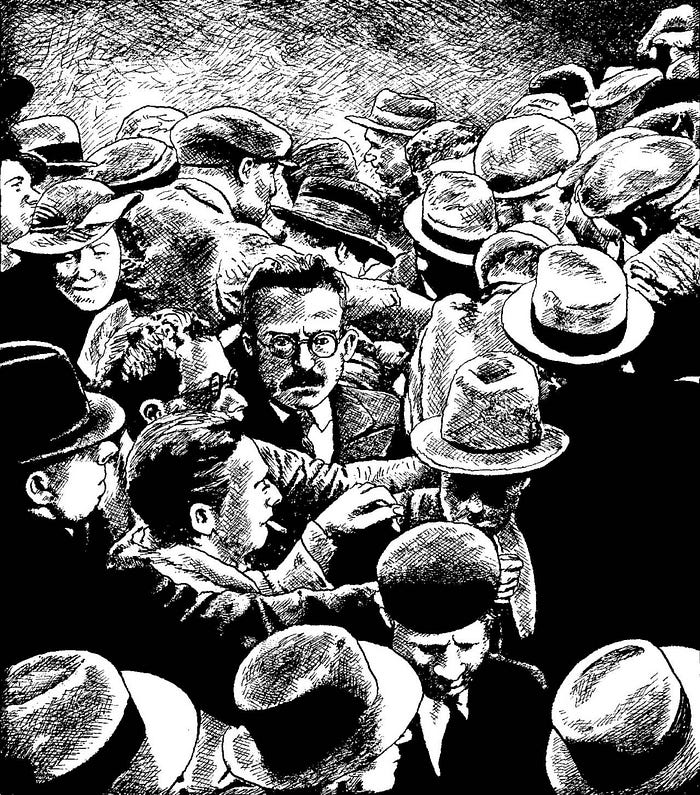
Brief History of a Project by Walter Benjamin
Walter Benjamin to Max Horkheimer, April 16, 1938
It’s during his time at university, between 1914 and 1915, that Walter Benjamin shows his first interest for Charles Baudelaire and, therefore, decides to start working on the translation of the Tableaux parisiens. The volume, enriched by the essay used as a programmatic premise on The Task of the Translator (1921), shall then be published only in 1923, with the title Charles Baudelaire. Deutsche Übertragungen mit einem Vorwort über die Aufgabe des Über-setzers von Walter Benjamin (Benjamin [1921]; Benjamin [1923]).
Four years later, a brief two months trip to Paris marks the start of The Arcades Project and, along with it, a return to the study of Baudelaire: in fact, Benjamin intends to write an article on the Parisian arcades, together with Franz Hessel. However, once he has returned to Berlin, he continues his work autonomously, gather-ing notes and materials: planning an essay that should be called Pariser Passagen. Eine dialektische Feerie [Paris Arcades: A Dialectical Fairyland], but then noticing that the project is starting to gain the substance of a book. Pariser Passagen II[The Arcades of Paris], written between 1928 and 1929, is the first draft of the new and more consistent project (Benjamin [1927–1940a]: 930–932; 919–925; 871–884).
Theodor Adorno and Max Horkheimer probably find out about it in September or October 1929 (maybe Adorno already in 1928), assisting the lecture of some of its parts during the course of their meetings with Benjamin at Frankfurt and Königstein. Shortly after, in 1930, the research comes to a halt, to then start again in 1934, when Benjamin is already in exile in Paris (on the other hand, the only place where he could carry out his study and work on documentation is the Bibliothèque nationale de France).
So, in May 1935 the first exposé with the title Paris, the Capital of the Nineteenth Century is ready (see Wohlfarth [2011]: 255–260). It is a particularly important moment: in fact, on one hand, with the 1935 exposé The Arcades Project is accepted in the program of works sponsored by the Institute for Social Research (with the title: The Social His-tory of the City of Paris in the 19th Century), on the other, it marks the start of the crucial theoretical debate with Adorno.
An epistolary correspondence, around which the work for the project on the Arcades develops, undergoing continuous changes and rewordings (see Eiland, Jennings [2014]: 483–575). On this account, the letters exchanged by the two philosophers between 1928 and 1940 are of fundamental value: they are not only a historical testimony, a «paratextual document», key for understanding the development of the project, but, in their peculiarity, they acquire the status of a literary work, one of the «most important ones of 19th-century philosophy», as it has already been pointed out (Desideri [2002]: 76–77; Wohlfarth [2011]: 261–269).
In the 1935 exposé, the fifth chapter goes under the title Baudelaire, or the Streets of Paris: the main topics regarding Benjamin’s interpretation of the lyric poet are already stated. The allegorical genius, the flâneur, the crowd, the bohèmeand the conspiracy, the modernity, the spleen and the idéal, the ever-selfsame and the new, l’art pour l ’a r t and the art market (Benjamin [1927–1940a]: 10–11). Adorno’s opinion of the text, however, is extremely critical. It’s the so called Hornberger Brief of August 2, 1935, in which Adorno disputes Benjamin’s formulation of the concept of dialektisches Bild, precisely, as exposed in the chapter on Baudelaire: the fetish character of the commodity as dialectical image internal to consciousness and intimately ambiguous is the main problem.
For Adorno, thinking the dialektisches Bild as being contained in a collective consciousness means to risk in proximity of Carl Gustav Jung and Ludwig Klages’ theories, of archaic-archetypical images, immanent to a supposed and timeless «collective ego». Benjamin’s exposé would still be lacking a theory that is able to dialectize both the ambiguity of the dialectical image and the relationship between society and the alienated individual. In other terms, the text, unlike the previous sketch of The Arcades of Paris that had found Adorno’s strong approval, insists excessively on the oneiric-mythical dimension rather than on the critical-dialectical one, taking the risk of becoming embroiled in the enchantments of the 19th century (Adorno, Benjamin [1928–1940]: 104–114).In his first brief reply to this letter, Benjamin clarifies that the first draft of The Arcades of Paris, has not at all been set aside, rather, in the over-all project of the book, it provides the thesis and the exposé is the antithesis.
The planned structure is already triadic and dialectic. Benjamin has «the two ends of the bow in hand», but what is still missing is the strength to arc it and shoot the arrow of the synthesis: the critical interpretation of the materials, that is to say of the 19th-century dreams. He is already basing his method on the constructive principle: «what the constructive moment means for this book must be com-pared with what the philosophers’ stone means for alchemy». It is within the construction that Benjamin seeks his very particular dialectics between image and awakening (Adorno, Benjamin [1928–1940]: 117–119).


No comments:
Post a Comment